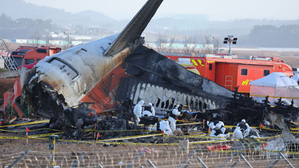Seoul, Dec 31 (IANS) South Korea’s aviation experts on Tuesday highlighted the need to revise regulations governing airport safety, including those on runway safety zones, amid growing views that a concrete structure near the runway may have exacerbated the severity of casualties in the Jeju Air crash this week.
The concrete structure near the runway at Muan International Airport holds a navigation system that assists in aircraft landings, known as a localiser, and is located about 250 metres from the end of the runway.
The Jeju Air B737-800 aircraft belly-landed at the airport and exploded on Sunday as it crashed into the structure, killing 179 of the 181 people on board.
Many experts have suggested the casualty count could have been much lower had the concrete structure not existed.
The transport ministry has defended the positioning of the localiser, stating that it was installed in compliance with existing regulations.
The government’s aviation obstacle management guideline requires all equipment or installations deemed obstacles on airport premises to be mounted on frangible structures, but this applies only within the designated runway end safety area (RESA).
RESA refers to the zone beyond the end of the runway designed to prevent aircraft damage in the event of an overrun or landing short of the runway.
The ministry said the localiser equipment at Muan was not subject to this requirement, as it had been set up outside the airport’s 199 metre-long RESA.
The minimum required RESA distance under international standards is 90 meters, according to the ministry, though the recommended distance is 240 metres.
The ministry acknowledged that some domestic airports, including those in Sacheon, Gyeongju and Muan, have RESAs shorter than the recommended 240 metres.
A separate government guideline pertaining to the design of airport and airfield facilities, meanwhile, stipulates that localisers should be included within the extended RESA for precision approach runways.
Experts, however, have emphasised the need to revise related regulations, with most agreeing that the presence of the localiser exacerbated the impact of the crash.
“While there may be no legal issues under current rules, these regulations date back to a time when accidents like this hadn’t occurred,” said Chung Yoon-shik, an aviation professor at Catholic Kwandong University.
“Now that an accident has happened, the regulations need to be improved,” he added.
Hwang Ho-won, a professor of aerospace law at Korea Aerospace University, echoed such a view, insisting that the issue is not solely about RESA distances.
“The improperly installed concrete mound should first be removed and an engineered materials arrestor system (EMAS) should be installed,” Hwang said.
EMAS allows aircraft to sink into a lightweight material, which helps planes to rapidly decelerate when overrunning a runway, Yonhap news agency reported.
Hwang added, “For airports with shorter RESA, an EMAS can significantly increase friction to reduce the speed of aircraft, enhancing safety during overruns or aborted takeoffs.”
–IANS
int/jk/as






























